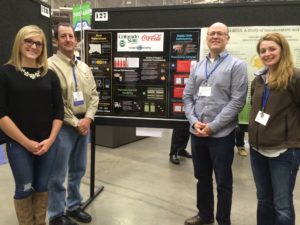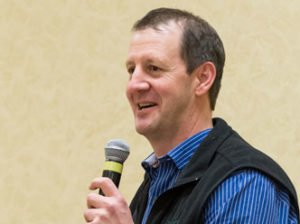Editor’s note: The Provost’s Council for Engagement is made up of a dozen faculty members representing all eight colleges and Morgan Library. Council members serve as champions for advancing the practice and recognition of engaged scholarship as fully embedded within CSU’s core teaching, research and service missions. Each month we are profiling a different member of the Council, who will in their own words help to showcase the diversity of engaged scholarship across campus, as well as the impact of this engagement work on communities and the university. Three council members – Martin Carcasson, Christine Fruhauf and Neil Grigg – have been profiled.
This month we meet Bill Shuster, who has taught at Colorado State University for 16 years and is a clinical professor of organization and innovation management in the Department of Management in the College of Business.
His primary role is teaching business capstone, supply chain practicum, and international business courses, while providing support for students in their career development. Shuster is a past recipient of the Professor of the Year by the CSU Business College Council, is an Honorary Inductee for Golden Key Honor Society and Sigma Iota Epsilon, a CSU Honor alumnus, and last month was named one of CSU’s Best Teachers by the Alumni Association.
Shuster was inspired to teach by both his parents, who were educators in small schools in Colorado. His philosophy on teaching? “Teach students how to think and not what to think.”
What, in your opinion, is ‘faculty engagement’?
“Faculty engagement can have many definitions, based upon the college, the discipline and the discovery goals for both the student and the faculty member. For me, this term represents bundling. Why should best practice research, the inquiry of student learning and faculty service be viewed as three separate boxes? If those factors are integrated, everyone wins and we can create a value multiplier effect.
From my perspective, it allows me to partner with students to test theory and design with outside entities, giving both groups a new understanding. I call these engagement efforts playing in the mud. It has been noted that experience is the best teacher. The more experiences students have and the more experiences faculty have, the more we learn.”
How have you, your program or students benefitted from what you have learned as an engaged faculty member? Has there been any sort of reciprocity with the communities outside of CSU that you have been involved with?

“In the College of Business, I have been teaching experiential or engagement classes for 16 years. Students have been involved in utilizing course content to create value for organizations as large as Lockheed Martin in Denver and as small as Dsenyo in Malawi, Africa. Being engaged allows the content to be relevant for undergraduate students, while adding value to outside constituent groups. Pretty cool concept. Students have the same learning objectives as they would in a regular class, have the opportunity to test drive those skills with a client, and the client is the recipient of value.
Our clients come to us because they have unsolved problems and need an outside viewpoint. In our Supply Chain Practicum, we have partner companies that are in need of less costly shipping channels, more robust supplier sourcing data or better inventory management process, to name a few, and they utilize the class and the students to solve those problems.
The students are treated as peers and spend an entire semester partnering (key word partnering) with these firm and are expected to deliver value at the end of the semester. The undergraduates involved in these classes now have ‘a place’ to put their learning and their professional evolution is exponential. As a faculty member, my learning is also exponential, as each project and company is unique and different.
These types of efforts demonstrate the value of partnerships. The students most definitely win with outstanding skills and resume. The partner organizations win by receiving value from the projects. Faculty also wins via the network effect. This network effect is demonstrated by seeing the effect of best practices on a real life situation. What factors stand up? What factors look good on paper, but don’t address the time compression dilemma of an integrated global society?”
Why are you involved with this council? How does it relate to your work or research?
 “My involvement revolves around the teaching side. Engagement has many shades and levels of involvement. Some faculty members may perceive that it is only for certain disciplines or that it will take too much time. It can be utilized for all disciplines, and it is up to the faculty member to determine how much time and effort is dedicated toward engagement.
“My involvement revolves around the teaching side. Engagement has many shades and levels of involvement. Some faculty members may perceive that it is only for certain disciplines or that it will take too much time. It can be utilized for all disciplines, and it is up to the faculty member to determine how much time and effort is dedicated toward engagement.
Being able to systemize knowledge to enhance faculty awareness on engagement is my primary reason for being involved. Half of my teaching load is with engaged/experiential classes. I get to sit in these council meetings and learn from the best on campus. Let me get this straight, I am getting paid to learn from the best on campus across eight colleges at a great university … Life is good.”
What do you hope the council is able to accomplish?
“I hope we can develop a user-friendly system that integrates engagement into academic disciplines. There cannot be a one-size-fits-all definition, due to the varying nature of each content area, but if engagement is just something a few faculty members participate in and it is not part of an overall system, the acquisition of new learning will suffer, as will student learning.
The council is more a bottom-up approach, but there is top support. This is our shot to integrate engagement into the day-to-day work life of many faculty members.”
Any other thoughts on the Provost’s Council for Engagement?
“This a unique opportunity with unique timing to create something that will impact many, both inside and outside of the university, and has the backing of university administration. This council signifies the land-grant mission of Colorado State University.
With that said, it is up to the council to drive the appropriate shifts to integrate engagement more broadly into the university mindset via practice, system and awareness.”